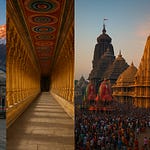Nestled in the serene town of Tulsipur in Balrampur district of Uttar Pradesh, Pateshwari Devi Temple, also known as Devi Patan Temple, is one of the most revered and ancient Shaktipeeths (seats of divine feminine power) in India. Believed to be one of the 51 sacred spots where parts of Goddess Sati’s body fell, this temple is a powerful pilgrimage site where millions gather every year, especially during Navratri, to seek blessings of Maa Pateshwari, a fierce and benevolent form of Goddess Durga.
Mythological Origin and Significance
The temple’s divine roots trace back to the mythology of Goddess Sati and Lord Shiva. As per ancient Hindu scriptures, when Sati immolated herself in the fire of yajna organized by her father Daksha, an enraged Lord Shiva carried her burning corpse and roamed across the universe in grief. To bring cosmic order, Lord Vishnu used his Sudarshan Chakra to dismember her body, and the parts fell in various places across the Indian subcontinent, creating the sacred Shaktipeeths.
It is believed that Sati’s left shoulder (or in some beliefs, her right thigh) fell at Tulsipur, making it an energy center of divine feminine power. This is why the presiding deity is worshipped here as Maa Pateshwari or Devi Patan, an epithet for "The Goddess of the Region."
Historical Background
The temple has deep historical relevance dating back to the 11th century.
It is said that King Ratan Sen of the Kalhans dynasty reconstructed this temple after being guided by divine visions.
The site is also mentioned in various Puranic texts, and its importance is referenced in Tantric and Shakta literature.
Over the centuries, the temple became a major spiritual hub in eastern Uttar Pradesh and neighboring Nepal, attracting sages, sadhus, tantriks, and devotees.
Architectural Insights
The temple exhibits North Indian Nagara-style architecture, with a towering shikhara (spire), intricately carved pillars, and stone inscriptions.
Key architectural elements include:
A sanctum sanctorum (garbhagriha) where the idol of Maa Pateshwari is enshrined.
Beautiful mandapas (pillared halls) for devotees to gather and chant.
An ancient yajna shala (fire altar) for rituals and homas.
A meditation cave used historically by sages and tantriks for sadhana.
Religious and Cultural Significance
As a Shaktipeeth, the temple is one of the most spiritually potent places for worshipping Devi Durga in her fierce form. It is associated with protection, strength, wisdom, fertility, and spiritual awakening.
Beliefs include:
Fulfillment of wishes related to marriage, children, education, health, and protection.
Worship here is said to remove obstacles, pacify planetary doshas, and eliminate fear.
The temple is a center of Shaktism, Tantra practices, and spiritual awakening.
Rituals, Worship, and Festivities
Daily Worship:
Mangala Aarti (Morning Aarti) – 5:00 AM
Shringar Aarti (Decoration) – 7:30 AM
Madhyahna Aarti (Noon Aarti) – 12:00 PM
Sandhya Aarti (Evening Aarti) – 6:30 PM (Summer), 5:30 PM (Winter)
Shayan Aarti (Night Aarti) – 8:00 PM
Major Rituals:
Navratri Celebrations (Chaitra & Ashwin) – Tens of thousands of devotees visit during these 9-day festivals.
Kanya Pujan – Worship of young girls as manifestations of the Goddess.
Havan & Yajnas – Fire rituals performed for health, prosperity, and divine blessings.
Sindoor and Chunari offering – Traditional way of offering respect and devotion to the Goddess.
Animal sacrifice was practiced in older times but now mostly symbolic or stopped.
Fairs and Festivals
Navratri Mela (Spring & Autumn) – Grand fair with spiritual gatherings, stalls, food, and cultural programs.
Vijayadashami/Dussehra – Celebrated with Durga visarjan yatra and victory processions.
Guru Purnima & Full Moon Days – Special bhajans, satsangs, and community feasts.
Deepawali and Kartik Purnima – Devotees light diyas and perform Lakshmi and Durga puja.
Nearby Religious Attractions
Hanuman Mandir – Located within the complex, symbolizing strength and devotion.
Lord Shiva Temple – For those who wish to balance Shiva-Shakti energy.
Meditation Cave – Open to spiritual seekers and sadhaks.
Ancient Water Pond (Kund) – Considered sacred for rituals and purification.
How to Reach Pateshwari Devi Temple, Tulsipur
📍 Location: Tulsipur, Balrampur District, Uttar Pradesh – Near India-Nepal border
By Road:
Well-connected by buses and private taxis from Lucknow, Gonda, Bahraich, Gorakhpur, Shravasti.
By Rail:
Nearest railway station: Tulsipur (local), Balrampur Junction (~30 km)
Trains available from Lucknow, Gorakhpur, Delhi
By Air:
Nearest Airports:
Gorakhpur Airport – 180 km
Lucknow Airport – 190 km
Accommodation & Facilities
Temple Trust Dharamshalas – Free and low-cost accommodations for pilgrims
Budget to Luxury Hotels available in Tulsipur and Balrampur
Vegetarian food stalls, water facilities, prasad counters, and toilets are maintained regularly
Security and medical aid available during big festivals
Spiritual Testimonials and Local Beliefs
Many devotees claim miraculous healing and blessings after visiting the temple.
Devotees offer coconuts, bangles, saris, red cloth, and sindoor after their wishes are fulfilled.
It is said that one visit with pure devotion to Maa Pateshwari can change your destiny.
The Pateshwari Devi Temple in Tulsipur is not just a place of worship—it is a spiritual powerhouse, a place where the divine feminine energy is alive and compassionate. If you're seeking inner strength, peace, spiritual experience, or divine intervention, this temple should be on your pilgrimage list.
Whether you're a devout Hindu, a spiritual seeker, or a traveler exploring India’s rich cultural fabric—Maa Pateshwari's abode offers you solace, blessings, and transformation.










